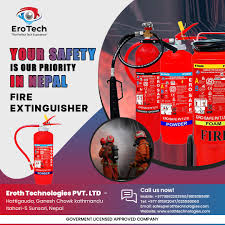Fire safety is a growing concern worldwide, and Nepal is no exception. With rapid urbanization, increasing infrastructure, and a growing population, the risk of fire hazards has also intensified. This makes the installation and maintenance of fire safety systems not just necessary but critical. Among the most effective and commonly used systems for combating fire are fire hydrant systems. In this article, we will explore the landscape of fire hydrant in Nepal, covering everything from its importance, components, regulations, benefits, to the future of fire safety in the region.
Understanding Fire Hydrant Systems
A fire hydrant system is an essential part of a building’s fire protection strategy. These systems are designed to provide a readily available water supply to fight fires. The system includes underground and above-ground components such as pipes, hydrants, valves, and pumps, all working in unison to ensure water is accessible in emergencies.
Components of a Fire Hydrant System:
-
Water Supply Network: Connected to a reliable water source, typically municipal water or storage tanks.
-
Hydrant Outlets: External points where firefighters or trained personnel can attach hoses.
-
Control Valves: Used to manage water pressure and flow.
-
Pumps: Increase water pressure to ensure effective fire suppression.
-
Hoses and Nozzles: Allow directional water flow to targeted fire zones.
Importance of Fire Hydrants in Nepal
The importance of fire hydrants in Nepal cannot be overstated. Given the geographical and infrastructural challenges in many Nepali cities and rural areas, quick response times are essential in case of fire outbreaks. Fire hydrant systems serve as the first line of defense against fire, especially in commercial complexes, factories, residential buildings, and public places.
Fire Risk Landscape in Nepal:
-
Dense Urban Areas: Cities like Kathmandu, Pokhara, and Lalitpur are densely populated, increasing the risk of fire spreading quickly.
-
Old Electrical Infrastructure: Many neighborhoods have outdated wiring systems, a major cause of electrical fires.
-
Flammable Building Materials: In older buildings, flammable wood and thatch are still commonly used.
Key Benefits:
-
Rapid water access
-
Minimizes fire damage
-
Saves lives and property
-
Reduces response time for firefighters
The Current Scenario: Fire Hydrant in Nepal
As fire safety awareness grows, the integration of modern fire hydrant in Nepal is gradually improving. Many government bodies, private sectors, and NGOs are taking steps to implement fire hydrant systems in vulnerable zones.
Implementation in Major Cities:
-
Kathmandu Metropolitan City has initiated projects to install hydrants in public squares and strategic locations.
-
Pokhara and Butwal are seeing gradual integration of hydrant systems in industrial and commercial zones.
-
Hospitals, schools, and hotels are increasingly incorporating hydrant systems as part of their mandatory safety protocols.
Government Regulations and Standards
The Nepal government, through the Department of Urban Development and Building Construction (DUDBC) and Nepal Fire and Rescue Services, has laid down fire safety guidelines. Although enforcement remains a challenge, the legal framework encourages the integration of fire hydrants in new constructions and renovations.
Relevant Codes and Acts:
-
National Building Code of Nepal mandates fire protection systems in high-rise buildings.
-
Local Government Acts empower municipalities to enforce fire safety standards.
These laws are not only important for ensuring safety but also for obtaining occupancy certificates and insurance approvals.
Technological Advancements in Fire Hydrant Systems
With global advancements in technology, Nepal is also witnessing the integration of smart solutions into fire safety systems.
Smart Hydrant Technology:
-
GPS-enabled Hydrants: Help responders locate hydrants quickly.
-
Remote Monitoring: IoT-based sensors can monitor water pressure and maintenance needs.
-
Automation: Integration with fire alarm systems to automatically activate pumps and alert fire services.
These technologies are slowly making their way into Nepal’s more developed sectors such as airports, large malls, and international hotels.
Challenges in Implementation
Despite the advantages, implementing fire hydrant systems in Nepal is not without its hurdles.
Key Challenges:
-
Infrastructure Issues: In many cities, water supply systems are outdated or insufficient.
-
Lack of Awareness: Many property owners are unaware of fire safety protocols.
-
Budget Constraints: Municipal budgets often prioritize road and drainage over fire safety.
-
Limited Fire Training: Even when systems exist, proper usage and maintenance knowledge is lacking.
Solving these issues requires a collaborative effort between government agencies, private enterprises, and the public.
Role of Eroth Technologies
Eroth Technologies is playing a vital role in revolutionizing fire safety in Nepal. By offering state-of-the-art fire hydrant in Nepal, Eroth ensures that communities and businesses have access to reliable and efficient fire protection systems.
What Sets Eroth Apart:
-
Custom-designed hydrant systems based on location-specific needs
-
Use of high-quality materials and smart technologies
-
Regular maintenance and support
-
Training and fire drills for staff and communities
Whether it’s a new installation or upgrading an existing system, Eroth Technologies ensures that fire safety remains a priority.
Maintenance and Training
Simply installing a fire hydrant system isn’t enough. Regular maintenance and proper training are key to ensuring its functionality during emergencies.
Maintenance Checklist:
-
Regular inspection of hydrant heads
-
Testing water pressure levels
-
Checking valves and pumps
-
Flushing out debris from pipes
Fire Drill Training:
-
Hands-on usage of hydrant hoses
-
Evacuation planning
-
Safety protocols during fire outbreaks
Such training should be conducted every 6 to 12 months, and documented for regulatory compliance.
Community Involvement and Awareness
Community awareness is crucial for the success of any safety initiative. Campaigns and workshops can be organized to inform the general public about how to use fire hydrants, basic fire safety, and emergency contacts.
Awareness Strategies:
-
Fire safety education in schools
-
Public service announcements
-
Neighborhood watch programs with fire training
-
Distribution of fire safety brochures
These efforts help build a safety-first culture in urban and rural communities alike.
Future Outlook: Fire Hydrant Systems in Nepal
The future of fire safety in Nepal looks promising with the government’s increasing focus on disaster preparedness, and the private sector’s growing investment in infrastructure safety.
What to Expect:
-
Expansion of hydrant networks in semi-urban and rural areas
-
Integration with national disaster response strategies
-
Increase in public-private partnerships for safety infrastructure
-
More stringent building codes and safety regulations
With smart planning and committed execution, fire hydrant systems will become a standard feature in all types of properties across Nepal.
Conclusion
Fire safety should never be an afterthought, especially in a country like Nepal where both natural and man-made disasters are frequent. The implementation of an effective fire hydrant in Nepal is a step towards a safer, more prepared society. As technology advances and awareness grows, fire hydrant systems will become an integral part of urban planning, building design, and public safety strategies. Organizations like Eroth Technologies are leading the charge in transforming this vision into reality by offering innovative, reliable, and accessible fire safety solutions.
For every homeowner, builder, business owner, or policymaker, now is the time to take fire safety seriously. Installing and maintaining a fire hydrant system isn’t just about compliance—it’s about protecting lives and assets.



